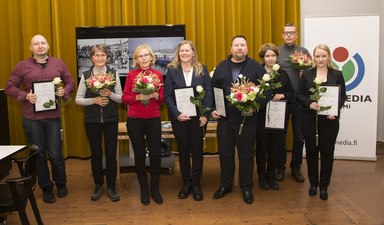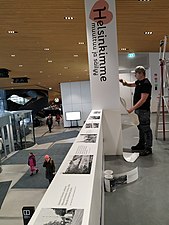GLAM/Newsletter/November 2019/Contents/Finland report
|
Combining the old and the new
Continuing where we left off at WikidataCon

At WikidataCon at the end of October, Robin van der Vliet and Kimberli Mäkäräinen got to talking about running a bot to automatically create simple descriptions in Northern Saami in Wikidata, as Robin’s bot has already been doing this there in Dutch, West Frisian, and Esperanto. To do so, we would need a table of nationalities and occupations, of which Kimberli already had a table of nationalities.
At Wiki Techstorm, Kimberli asked Mewasul from Wikimedia Norway if she would be interested in combining the two lists. Happily, she agreed to do so and now we have a list of 294 nationalities and other geography-related adjectives that will be imported into Wikidata. We also discovered 26 adjectives that we do not know the equivalent of in Northern Saami, so this list will be sent to the language authorities at Sámi Giellagáldu. Future plans include finding out the equivalent in the other Saami languages. Now to get cracking on the occupations!
HelMet libraries and the Finnish Museum Card
During the workshop about scraping websites on Friday evening, Hay used the Dutch Museum Card (Museumkaart) as a typical example of what he would do with Wikidata. He also told us about how it had been included as a payment type for more than 400 museums in Wikidata. Intrigued, Kimberli decided to compare the results of that query with those of the corresponding Finnish Museum Card (Museokortti). To her surprise, only 1 museum of the 294 museums in Finland that accept Museokortti, the Finnish Museum of Games, was listed as accepting it. It was decided to turn this into a small project to include this in each museum’s Wikidata item. This project is still ongoing.
The next day, while participating in the mapmaking workshop, Kimberli decided to change the sparQL query of all public libraries in the Netherlands to draw a neat map of the HelMet libraries in the Helsinki Metropolitan Area of Finland for use in a Wikipedia article. This was not possible though. Upon remarking about this to Michelle Boon of Wikimedia Nederland, they decided to scrape the HelMet website and a few others to improve the data for these libraries in Wikidata based on the way this data has been modelled for Dutch public libraries. Although this data has been uploaded to Wikidata, we have found new pieces of information that are missing out of Wikidata, preventing us from adding in some of the properties that we would like the items to have. Nonetheless, the massive amount of new data that has already been uploaded will already greatly enrich the ways in which these items can be reused.
Wiki Loves Monuments award ceremony
The theme of this year's Wiki Loves Monuments in Finland was Sacred Place. The winner of the competition was Eerik Lehto with his photograph of the Haltioletto burial island in Jerisjärvi. The jury concluded: ”A photograph of an ancient burial island, a Saami grave field, and an offering site brings together beautifully the modes of life and the bond with nature of an ancient people. The image respects the Saami sacred place from a distance with dignity. The small island stands out from its surroundings elegantly and is unassumingly present.”
In addition to the standard WLM competition, Finland also organizes a unique rephotography track. This year, this track had two separate series: Signe Brander’s Helsinki and Lost Places and Buildings. The first series was won by Marit Henriksson and the top prize in the second series was shared by Raine Virtanen and Jorma Lindqvist. In addition, Merja Wesander received an award for taking the most pictures.
One week before the award ceremony, we gave a presentation about the results of the Wiki Loves Monuments competition and rephotography track at the Photo Archive Days held at the National Museum of Finland.
The award ceremony was also held at the National Museum, co-hosted by Wikimedia Finland and the Finnish Heritage Agency. "The third edition of Wiki Loves Monuments has established its position in exposing cultural heritage. It produced once again gorgeous interpretations of cultural heritage that are meaningful to people. We are glad to be partnering [with Wikimedia Finland] in the competition," states Chief Intendant Ulla Salmela from the Finnish Heritage Agency.
Two people were invited to be mentors for the competition: Senior Forest Culture Specialist Reetta Karhunkorva from Lusto – The Finnish Forest Museum] and the Secretary General of the Skolt Sámi Cultural Foundation Mari Korpimäki. The rest of the jury consisted of Chief Curator of Collections Anni Wallenius from the Finnish Museum of Photography as chairperson of the jury, researcher Yki Hytönen from Helsinki City Museum's Picture Collections, Board member Hanna Mäki from Wikimedia Finland, and photographer Soile Tirilä from the Photo Collections of the Finnish Heritage Agency.
See all the Finnish winners at the Wiki Loves Monuments website.
-
Haltioletto by Eerik Lehto.
-
The winners of the WLM 2019 Finland Alexander Popkov, Merja Wesander, Marit Henriksson, Maarit Siitonen, Eerik Lehto, Katja Kapanen, Raine Virtanen, and Heini Dahlroos. Photo: Soile Tirilä.
-
One of the rephotogaraphed images in Marit Henriksson's winning series. Harbour track in the Southern Harbour by the Market Square, by Signe Brander.
-
Former Harbour track, by Marit Henriksson.
Helsinki: then and now
The end of the first year of our Helsinki rephotography project saw us curate a photography exhibition on the history of Helsinki in the Helsinki Central Library Oodi. The idea for the exhibition was to use openly licensed content to show how the Helsinki cityscape has changed over time. We used content from the Wiki Loves Monuments competition and Helsinki rephotography together with photos from the Helsinki City Museum and maps from the City Archive. In addition to static photos, we implemented tablet interfaces for annotating and browsing the photos.
With one tablet, we can collect information from users on whether groups of people are young or old or if they’re male, non-binari, or female. On the second tablet, we collect information about the scene in the photo. For example, is the scene indoors or outdoors, taken on the street level or from above, is it artificial or natural. With the third tablet, we have a browsing interface where the viewer can see pairs of photos showing the old and new Helsinki on a map. This was crashtested with a swarm of curious children during Oodi’s 1-year birthday on December 5, 2019, as Brygga and we organized a cut-draw-invent-future Helsinki handicraft workshop as part of the program.
In the spirit of the UN's International Year of the Indigenous Language and to continue Wikimedia Finland's commitment to multilingualism and linguistic diversity, we crowdsourced the phrases Helsinki then and now and Helsinkimme muuttuu ja säilyy into different languages. The first phrase was translated the most, into a total of 39 languages. The second one was translated into 12 languages other than Finnish. The languages ranged from Armenian to Riffian and back again.
The Helsinki Rephotography exhibition opened the third week of November 2019 in Brygga, an event and exhibition space run by the Helsinki Urban Environment Division. The exhibition, which is a collaboration between Wikimedia Finland and Ajapaik, will be on display until the end of February 2020.
-
Building the Helsinki Then and Now exhibition
-
Overview of exhibition
-
Outside of the event balcony Brygga.
-
People browsing the photos with a map Oodi's birthday on December 5, 2019.
-
People investigating the map of Helsinki in 1909 on the floor.
Edit:History in Aboa Vetus & Ars Nova in Turku and Vapriikki in Tampere

The museums Aboa Vetus & Ars Nova in Turku and the The Finnish Museum of Games in Tampere are exploring the possibilities of engaging their communities with Wikidata in the project Edit:History. Aboa Vetus & Ars Nova hosted a workshop for the public, while the Finnish Museum of Games hosted a workshop for the personnel of the museum complex Vapriikki.
Both workshops started to weave a web of historical personalities, places, and actors. In The residents of the Cloister Quarter project in Turku, the focus was on people who had lived in the medieval quarters that the museum currently occupies. In the Industry of Tampere project, we started mapping the corporations of the early industrial era in Tampere and the people related to them. The spark of linked data is lit in both places!
| Home | About | Archives | Subscribe | Suggestions | Newsroom |











